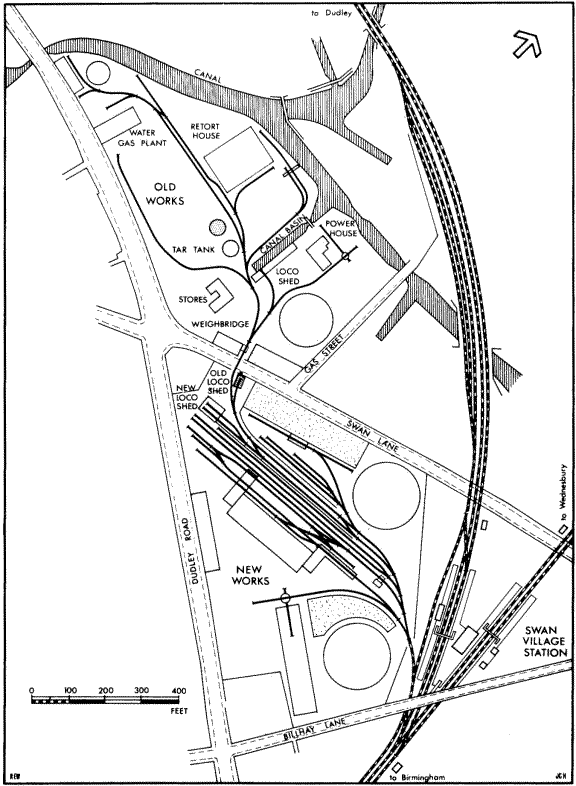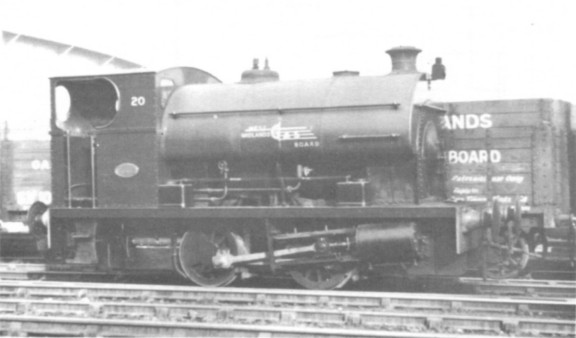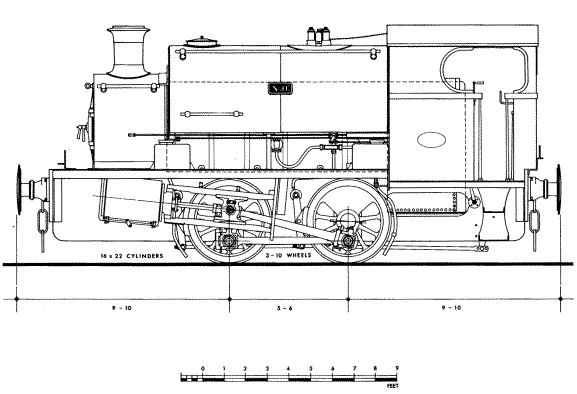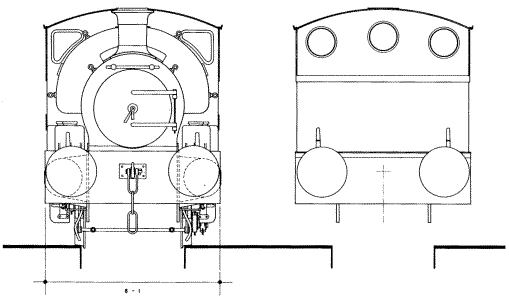
| THE INDUSTRIAL RAILWAY RECORD |
© AUGUST 1968 |
SWAN VILLAGE
GAS WORKS
COLIN BETTS
Swan Village Gas Works was the first industrial railway system I knew. As a boy of no more than ten its Bagnall saddle tank gave me my first footplate ride. So when I learned that changed conditions had all but terminated its rail traffic my mind was flooded with pleasant memories of forty years ago. It seemed worthwhile to put pen to paper.
I was born and bred in West Bromwich, a large town in Staffordshire, better known for its football team, and here I spent my first twenty-three years. In a town of many railway stations our nearest was Swan Village, a junction on the GWR which had four signal boxes. Two of these, the West and the North, controlled level crossings in Swan Lane and at the Dudley end of the same there was yet a third level crossing - an ungated one with its rails set in cobble stones - over which plied the saddle tank mentioned.
I am bound to admit (though somewhat shamefacedly to fellow members) that even as a schoolboy I was more interested in railway operation than locomotives pure and simple. I wanted to know why, on the GWR tracks, some goods trains were made up of covered wagons, others mostly trucks, or why some local goods trains were allowed to travel brake van first. Above all I wanted to know about the mysterious messages rung out by single tapper bells in the signal boxes. But although the main line traffic was interesting because it had variety I found time to note also the railway activities of, the gas works.
We can take the period to be sometime between 1927 and 1930, although I do not think that things altered much until 1950 or so. From the Up branch line (altered in more recent times to the Down branch line was the siding connection into the reception sidings controlled by the Junction signal box. There was the inevitable five-barred gate at the entrance indicating the boundary of ownership between the railway company and the gas works. And on a post near the gate was a telephone in a little box used by the shunter to advise the signalman, who was unable to see the situation himself, when trains wanted to shunt or make movements on to the main line. To the left of the track was the large No.2 gasholder.
Once inside gas works territory the single track fanned out into four or five sidings which accommodated about 100 wagons. On the perimeter of the sidings stretching to Bilhay Lane and Swan Lane were areas of coarse rough grass. Little did I think then, as a schoolboy, that this unused land would in due course become a completely new gas works.
My vantage point, of course, lay at the level crossing. The original engine shed holding but a single loco and now demolished, was situated on a short dead-end spur. Herein lived FORWARD No.3. Like all the saddle tanks that ever worked at Swan Village it was four-coupled because of the small radiused curves in the works. The driver, I recall, was named Taylor. He had a large walrus moustache. His shunter, a short affable fellow, slightly bow-legged, was named Webster, and he was promoted to driver when Taylor suddenly died.

Official works photograph of FORWARD No.3, Bagnall 1681 of 1903. (Courtesy English Electric Co Ltd)

The "New Works" from Swan Village station. (Author)

20, Peckett 2032 of 1942 in March 1957. (K.P. Plant)

21, Hudswell Clarke 1734 of 1943 in March 1957. (K.P. Plant)


Peckett 2081 of 1947 - Drawing by Roger West
The locomotive's work was simple enough. There were loaded coal wagons to be propelled from the sidings into the works over the level crossing, and there were empties and coke to be brought back. From the sidings to the works was a fairly steep falling gradient and the load was restricted to three full loaded wagons though not, I suspect, because of the load but to minimise the hold-up of road traffic. As the train approached the level crossing the shunter walked ahead and a blast from the whistle brought out a man in uniform - a sort of crossing keeper/time keeper - from his little office at the works entrance. Here each wagon was weighed and as noted above this tended to hold up, even in those days, the road traffic. This was the era of the privately owned wagon and I recall a certain monotony about those large black wagons with "City of Birmingham Gas Department" in large white letters.
The works, now known as the "old" works, are indeed old. William Murdoch first gaslit his cottage in Redruth, Cornwall, in 1797. A royal charter founded the Birmingham Gas Light and Coke Company in 1812. Thirteen years later the Birmingham and Staffordshire Gas Light Company was formed to manufacture and supply gas to Birmingham and a number of surrounding towns. Its works at Swan Village when completed in 1829 were the largest in the country. The events leading to their acquisition by Birmingham Corporation - an early example of municipalisation - make an interesting story.
It is recorded that both companies claimed equal rights to supply customers in the same streets. Competition became so intense that residents suffered in consequence and complained to the authorities about the continual breaking-up of the streets. The confusion was heightened by the occasional mistaken tapping of a rival's main when connecting the supply to a customer! Such a confused and uneconomic state of affairs could not continue, and in 1874 both companies promoted Parliamentary Bills to raise further capital for expansion. They were prepared to amalgamate in order to present a united front to an impatient Council and an exasperated public. But the Bills were thrown out, and a year later the companies became public property when Royal Assent was given to the Birmingham (Corporation) Gas Act.
In the middle of the "old" works is a canal basin and evidently early coal supplies came by barge. This traffic diminished after the railway from Wolverhampton to Birmingham was opened on 14th November 1854, and it is recorded that the first loco at Swan Village arrived about July 1882. Named FORWARD No.3 ("Forward" is the motto of the City of Birmingham) this was Peckett 426 of 1882; it was advertised for sale in the "Colliery Guardian" on 31st July 1903 and was later sold to M. Osborn & Company. FORWARD No.1 (Black Hawthorn 388 of 1877) was transferred from Saltley Gas Works in 1891, and I can remember it quite well because it was used whenever the second FORWARD No.3 (Bagnall 1681 of 1903) was out of service. Unlike No.3, which was green, No.1 was black. I have no recollection in those days of more than one loco being at Swan Village at a time and presume that No.1 was stored in reserve, possibly elsewhere.
Generally speaking one coal train came to the works each day, usually in the early afternoon and invariably hauled by a GWR pannier tank. It was the usual practice to store the full wagons in one of the two local goods yards. As mentioned above, in those days the siding connection lay off the Up branch, and trains were invariably propelled into the gas works. Because heavy up goods trains were banked, it was necessary to pin down the brakes of a few wagons - I have forgotten at this point in time just how many. The brakevan would then be uncoupled and, its hand-brake released, would run of its own momentum silently into the gas works reception sidings. This manoeuvre was necessary to prevent the brakevan being hemmed in at the buffer stops with its train of full coal wagons in front of it.
The siding connection from the Up branch was a small radius curve and more than one derailment occurred at the points. I remember one such derailment which took place just before Christmas 1930. I was then thirteen and this was the first railway "mishap" I had seen. The presence of the breakdown crane and gang working by tilley lamp in the early winter's evening provided great excitement.
In the ordinary course the gas works locomotive worked but a single shift, finishing each day (Saturdays included) at 16.30. but the crew, I seem to recall had some sort of relief. I have no knowledge of wartime conditions, but the event to change the pattern of many years' working was the decision to build a completely new works.
This was considered by the Gas Committee of the Birmingham City Council but the works were opened on 9th October 1953 by the Chairman of the Gas Council, nationalisation having taken place on 1st May 1949. It was fortunate that surplus land bought a century and a quarter previously allowed for expansion though it had been a long time a-coming! Included in the building of the new works was an engine shed housing four locos with facilities for maintenance and repairs. The increased rail traffic necessitated extensive new sidings outside the works to accommodate additional wagons. The internal sidings were remodelled to accommodate 157 wagons.
By this time FORWARD No.1 and No.3 had been scrapped; so too had 23 (Hawthorn Leslie 3183 of 1916) and 24 (Hawthorn Leslie 2584 of 1904). Two 204hp 0−4−0 diesels (Barclay 386 and 387 of 1952) were acquired for the new works with two more 0−4−0 saddle tanks - 20 (Peckett 2032 of 1942) and 21 (Hudswell Clarke 1734 of 1943) - in reserve. By 1965 these had all been scrapped or transferred away; 21 was scrapped in January 1962, No.1 (Barclay 386) went to Nechells Gas Works on 31st January 1964, 20 left for Foleshill Gas Works in August 1964, and finally No.2 (Barclay 387) departed for Nechells on 25th August 1965. Peckett 2081 of 1947 arrived from Nechells on 26th August 1965 to join a 180hp 0−4−0 diesel (North British 27544 of 1960) obtained from the liquidator of the North British Locomotive Company in June 1964.
* * *
Mr K.J. Crane, the works engineer at Swan Village, who has kindly confirmed the more recent locomotive movements, states that traffic has now virtually ceased because production of gas from coal had ceased. The works, however, continues to manufacture both water gas and oil gas.
Much then has changed in the 140 years' existence of the gas plant at Swan Village, in its needs for raw materials and in its forms and methods of transportation. Horse-drawn "narrow" boats were replaced by the railway and now the rail traffic itself has gone. The small boy who stood at the level crossing in the 1920's remembers the little Bagnall with affection.